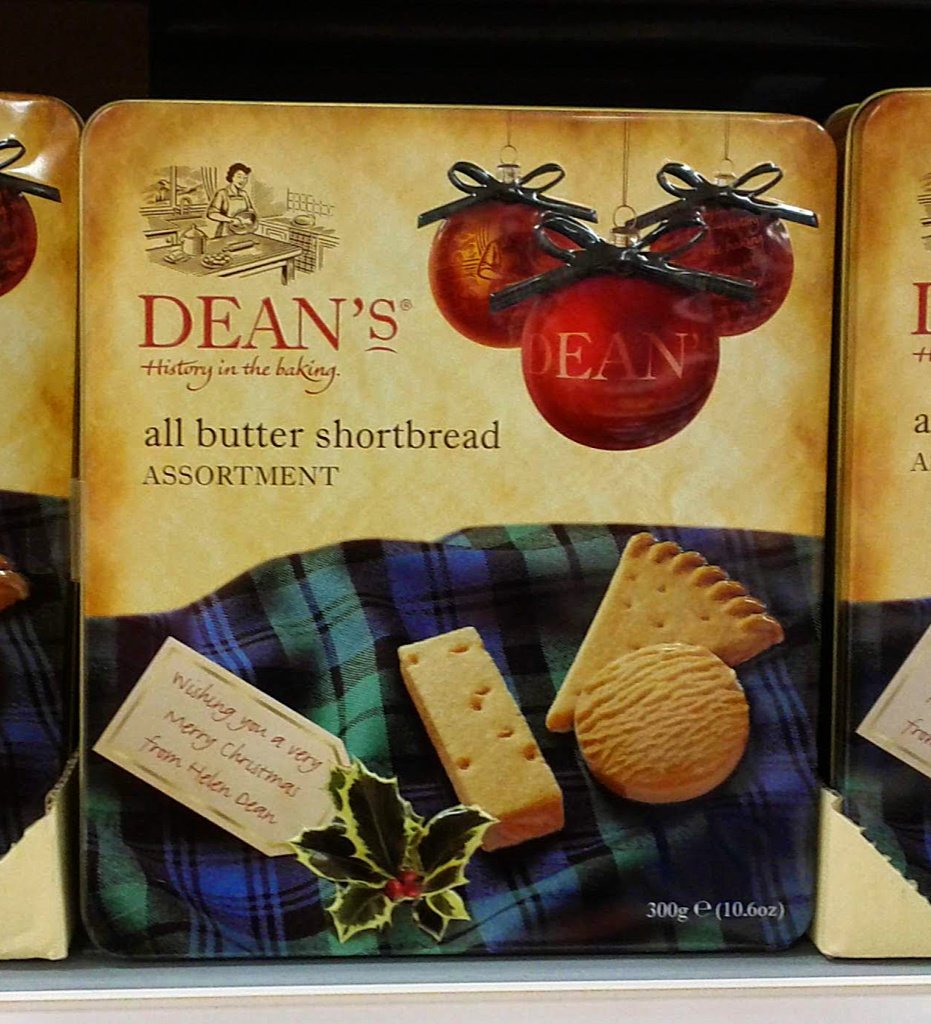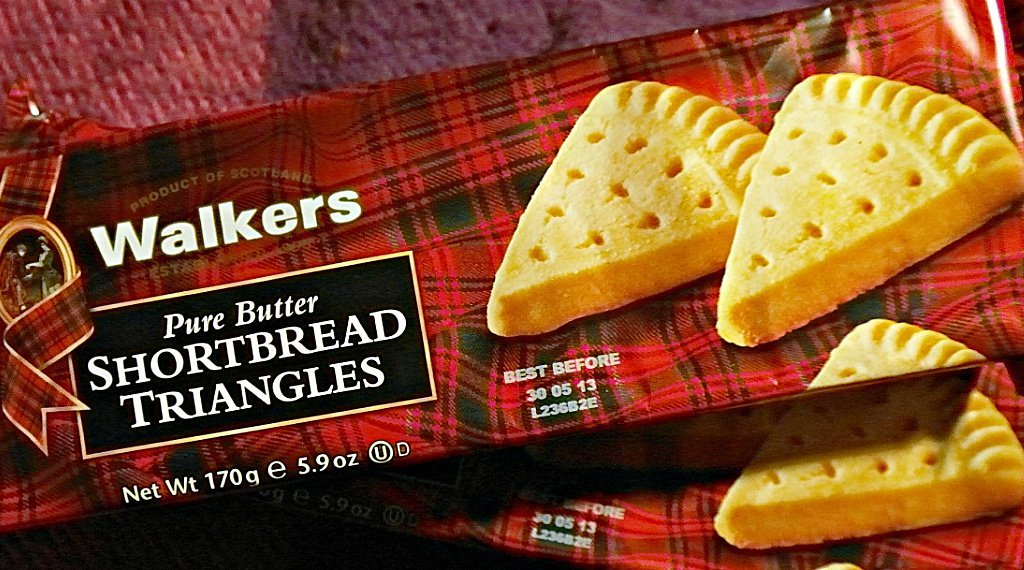Scottish shortbread, a buttery biscuit or cookie, is iconic like haggis, and still a favourite in Scotland. This page features a couple of easy to bake traditional shortbread recipes including petticoat tails.
The Scottish cookery carb-fest certainly includes Scottish shortbread, a sweet biscuit / cookie that is both still baked at home and also made and exported on an industrial scale.
A Scottish Shortbread Recipe
Here is an old traditional Scottish shortbread recipe, for a round of shortbread, baked as festive cake at Hogmanay (Scotland’s New Year Festival, formerly more important than Xmas).
Use 8 oz / 27g flour, 4 oz / 113g rice flour, 8 oz / 227g butter, 4oz / 113g caster sugar.
(By the way, thanks to Emsi who recently got in touch to point out I had originally spelt ‘caster’ as ‘castor’ and so French people think they have to use a special kind of sweetener made with beavers.) Anyway…
Carefully blend the butter and sugar by hand on a board. Mix the flour and rice flour together, then work this gradually into the butter and sugar, until the dough is of the consistency of short-crust.
Make sure it does not become oily (possibly in hot weather, therefore fairly unlikely in Scotland) or rubbery with over-mixing. The less it is kneaded the shorter and crisper the shortbread.

Do not roll out – as this can toughen the dough – but press by hand into two round cakes either in shortbread moulds or on baking-paper.
Pinch the edges all round by way of decoration and prick with a fork all over.
The proportions should be in the ratio of three-quarters of an inch thick for an 8 inch diameter cake. (That’s 1.9 x 20.3 cm.)
Oven cook for around 30 mins at 150 C. (gas mark 2) to get it crisp and very light golden brown.
Shortbread – Petticoat Tails
Scottish shortbread seems to have mediaeval origins as some kind of celebratory cake recipe.
One version of it is still seen as ‘petticoat tails’ – basically a round cake cut into sectors.
Sometimes you hear that it’s from the French ‘petites galettes’ meaning, apparently, little cakes. Hmm.
Way back in the mists of Scottish cookery lore, as an alternative explanation, the Annals of the Cleikum Club says ‘…we rather think the name petticoat tails has its origins in the shape of the cakes, which is exactly that of the bell-hoop petticoat of our ancient Court ladies.’
Here’s a recipe for the kind of shortbread we still call petticoat tails and it is based on the method as described in The Cook and Housewife’s Manual by Mistress Margaret Dods (Edinburgh, published 1826).
(She was the fictional Meg Dods, and the book was actually written by the wife of an Edinburgh publisher. Somewhat inevitably at this time in the city’s publishing circles, Sir Walter Scott is said to have had a hand in it. Enough already.)
Scottish Shortbread Recipe
To make Petticoat Tails
1.75lb (775gm) flour, 8oz (225gm) butter, 3oz (85gm) caster sugar, >.5oz (14gm) caraway seeds (if you really really must), .25pt (140ml) milk.
Add the caraway seeds, the fewer the better or, ideally, in my opinion, none at all, to the flour in a mixing bowl. (Eh? Well, the seeds get stuck in your teeth, don’t they?)
Stir the sugar into the flour.
Melt the butter (gently in a microwave), mix with the milk.
Make a hole in the centre of the flour and gently mix the wet ingredients into the dry.


Direct quote here: ‘Knead, but not too much, or it will be short.’ (ie leathery!)
Divide into two and roll out thinly.
Cut out the dough in a circle using, say, a dinner plate, as a template.
(At least, that’s the instruction in the original recipe, as neither of the alternatives, the frisbee or the hubcap, had been invented.
Oh, wait, neither had the microwave, as mentioned above.)
Here’s the ritualistic bit: now cut a small circle right in the centre of the large circle.
I’m reluctant to suggest what to use as a template, though an Amazon Echo Dot would be about right.
Then, using your geometrical knowledge, cut the round into eight equal sectors, except for the wee circle in the middle.
Bake on paper in a tin for approximately 20 mins at 180 degrees or until pale golden brown.
(Well, that last bit’s a cop-out. Might as well say ‘and don’t blame us if you burn them’.)
Serve in the same shape as they were baked, ie with the wee round one in the middle.
Scottish Shortbread As Souvenirs Or ‘Off The Shelf’
There are a number of big names in Scotland’s own shortbread industry. Their products are widely available. These include Walkers of Aberlour.
As a North-East loonie (laddie), I prefer Dean’s of Huntly, partly because their Scottish shortbread tastes nice.
Also irrationally, because my great-grandfather was the postman there, in Huntly in rural Aberdeenshire, after he left the Gordon Highlanders. See? Told it wasn’t rational.
(I’ve also gone off Walkers big-time since they started putting the Union Jack on their products. But enough already.)

Now, I recall threatening you with some geometry, having hit you with the mathematics of tartan elsewhere.
In their search for shortbread names, Walkers knew that, for example, ‘shortbread tangential quadrilaterals’ was never going to catch on.
Call me picky, but that term more accurately describes the shape of the shortbread in the picture.
Basically, it was too much of a mouthful (unlike their shortbread, which is usually just right for several mouthfuls).
So they thought about it a bit more and came up with ‘Shortbread triangles’, as pictured here. Aaargh! Terrible geometric mistake. Cancel the packaging order.
This shape, as every schoolboy knows, is really a sector (of a circle), geometrically speaking, because a triangle has straight sides.
‘Shortbread sectors’ – see? Not the worst name now, is it? Especially as Walkers are leading producers in the, uhmm, shortbread sector. My wife has just walked past, muttering ‘Shortbread anorak…’
(You know I’m making all of this up, don’t you?)
Anyway, if you find yourself in Aberlour on the River Spey – and it’s lovely country – as well as a shortbread factory that you can’t visit, Walkers have a shop, where you could ask if they stock tangential quadrilaterals.
This is our favourite book on the subject of Scottish baking.
And now…let’s go to Scottish scones. Johanna’s granny’s recipe – foolproof.